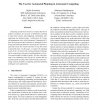Free Online Productivity Tools
i2Speak
i2Symbol
i2OCR
iTex2Img
iWeb2Print
iWeb2Shot
i2Type
iPdf2Split
iPdf2Merge
i2Bopomofo
i2Arabic
i2Style
i2Image
i2PDF
iLatex2Rtf
Sci2ools
ICAC
2005
IEEE
2005
IEEE
The Case for Automated Planning in Autonomic Computing
Computing systems have become so complex that the IT industry recognizes the necessity of deliberative methods to make these systems self-configuring, self-healing, selfoptimizing and self-protecting. Architectures for system self-management, also called Autonomic Computing (AC), have been proposed where elements are managed by monitoring and analyzing behaviors and using the response to plan and execute new actions that take or keep the system in desirable states. In this paper, we explore the planning needs of AC, its match with existing planning technology and its connections with policies and planning for web services and scientific workflows (grids). We show that planning is an evolutionary next step for AC systems that use procedural policies today. This connection also raises interesting research problems in adapting automated planning techniques to AC applications.
| Added | 24 Jun 2010 |
| Updated | 24 Jun 2010 |
| Type | Conference |
| Year | 2005 |
| Where | ICAC |
| Authors | Biplav Srivastava, Subbarao Kambhampati |
Comments (0)

